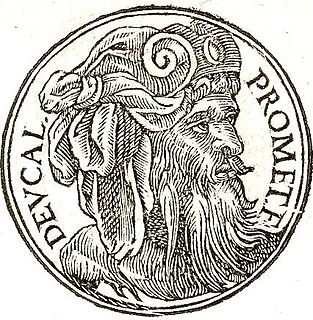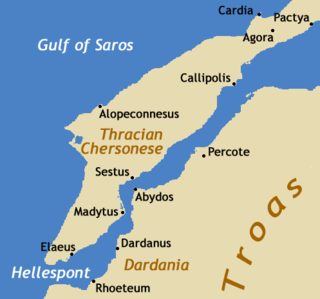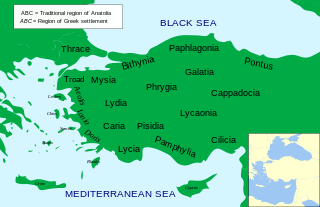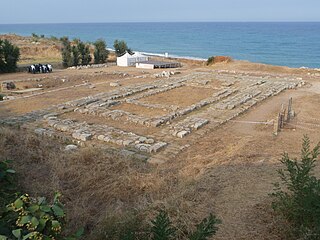Related Research Articles

In ancient Greek mythology and religion, Leto is a goddess and the mother of Apollo, the god of music, and Artemis, the goddess of the hunt. She is the daughter of the Titans Coeus and Phoebe, and the sister of Asteria.

Ionia was an ancient region on the western coast of Anatolia, to the south of present-day Izmir. It consisted of the northernmost territories of the Ionian League of Greek settlements. Never a unified state, it was named after the Ionian tribe who, in the Archaic Period, settled mainly the shores and islands of the Aegean Sea. Ionian states were identified by tradition and by their use of Eastern Greek.

In Greek mythology, Deucalion was the son of Prometheus; ancient sources name his mother as Clymene, Hesione, or Pronoia. He is closely connected with the flood myth in Greek mythology.

The Bibliotheca, also known as the Bibliotheca of Pseudo-Apollodorus, is a compendium of Greek myths and heroic legends, arranged in three books, generally dated to the first or second century AD.
Stephanus or Stephan of Byzantium, was a Byzantine grammarian and the author of an important geographical dictionary entitled Ethnica (Ἐθνικά). Only meagre fragments of the dictionary survive, but the epitome is extant, compiled by one Hermolaus, not otherwise identified.

Nicomedia was an ancient Greek city located in what is now Turkey. In 286, Nicomedia became the eastern and most senior capital city of the Roman Empire, a status which the city maintained during the Tetrarchy system (293–324).
The sibyls were prophetesses or oracles in Ancient Greece. The sibyls prophesied at holy sites. A sibyl at Delphi has been dated to as early as the eleventh century BC by Pausanias when he described local traditions in his writings from the second century AD. At first, there appears to have been only a single sibyl. By the fourth century BC, there appear to have been at least three more, Phrygian, Erythraean, and Hellespontine. By the first century BC, there were at least ten sibyls, located in Greece, Italy, the Levant, and Asia Minor.

Sybaris was an important city of Magna Graecia. It was situated in modern Calabria, in Southern Italy, between two rivers, the Crathis (Crati) and the Sybaris (Coscile).

Pausanias was a Greek traveler and geographer of the second century AD. He is famous for his Description of Greece, a lengthy work that describes ancient Greece from his firsthand observations. Description of Greece provides crucial information for making links between classical literature and modern archaeology.
Apollodorus of Athens son of Asclepiades, was a Greek scholar, historian, and grammarian. He was a pupil of Diogenes of Babylon, Panaetius the Stoic, and the grammarian Aristarchus of Samothrace, under whom he appears to have studied together with his contemporary Dionysius Thrax. He left Alexandria around 146 BC, most likely for Pergamon, and eventually settled in Athens.
Scymnus of Chios was a Greek geographer. It was thought he was the author of the Periodos to Nicomedes, a work on geography written in Classical Greek. It is an account of the world in 'comic' iambic trimeters which is dedicated to a King Nicomedes of Bithynia. This is either Nicomedes II Epiphanes who reigned from 149 BC for an unknown number of years or his son, Nicomedes III Euergetes.
Parthenius of Nicaea or Myrlea in Bithynia was a Greek grammarian and poet. According to the Suda, he was the son of Heraclides and Eudora, or according to Hermippus of Berytus, his mother's name was Tetha. He was taken prisoner by Helvius Cinna in the Mithridatic Wars and carried to Rome in 72 BC. He subsequently visited Neapolis, where he taught Greek to Virgil, according to Macrobius. Parthenius is said to have lived until the accession of Tiberius in 14 AD.

The First Mithridatic War was a war challenging the Roman Republic's expanding empire and rule over the Greek world. In this conflict, the Kingdom of Pontus and many Greek cities rebelling against Roman rule were led by Mithridates VI of Pontus against Rome and the allied Kingdom of Bithynia. The war lasted five years and ended in a Roman victory which forced Mithridates to abandon all of his conquests and return to Pontus. The conflict with Mithridates VI later resumed in two further Mithridatic Wars.
In Greek mythology, Makedon, also Macedon or Makednos, was the eponymous ancestor of the ancient Macedonians according to various ancient Greek fragmentary narratives. In most versions, he appears as a native or immigrant leader from Epirus, who gave his name to Macedonia, previously called Emathia according to Strabo, which according to Marsyas of Pella was until then a part of Thrace.

Elaeus, the “Olive City”, was an ancient Greek city located in Thrace, on the Thracian Chersonese. Elaeus was located at the southern end of the Hellespont near the southernmost point of the Thracian Chersonese in modern-day Turkey. According to the geographer Scymnus, Elaeus was founded by settlers from Ionian Teos, while the Pseudo-Scymnus writes that it was a colony of Athens and was founded by Phorbas

Mainake, Menace was an ancient Greek settlement lying in the southeast of Spain, according to the Greek geographer and historian Strabo (3,4,2) and Pausanias of Damascus. Pausanias adds that it was a colony of the Greek city of Massalia. Maria Eugenia Aubet locates it at the site of modern Málaga. The first colonial settlement in the area, dating from the late 8th century BC, was made by seafaring Phoenicians from Tyre, Lebanon, on an islet in the estuary of the Guadalhorce River at Cerro del Villar.

Mithridates or Mithradates VI Eupator was ruler of the Kingdom of Pontus in northern Anatolia from 120 to 63 BC, and one of the Roman Republic's most formidable and determined opponents. He was an effective, ambitious and ruthless ruler who sought to dominate Asia Minor and the Black Sea region, waging several hard-fought but ultimately unsuccessful wars to break Roman dominion over Asia and the Hellenic world. He has been called the greatest ruler of the Kingdom of Pontus. He cultivated an immunity to poisons by regularly ingesting sub-lethal doses; this practice, now called mithridatism, is named after him. After his death he became known as Mithridates the Great.

Classical Anatolia is Anatolia during Classical Antiquity. Early in that period, Anatolia was divided into several Iron Age kingdoms, most notably Lydia in the west, Phrygia in the center and Urartu in the east. Anatolia fell under Achaemenid Persian rule c. 550 BC. In the aftermath of the Greco-Persian Wars, all of Anatolia remained under Persian control except for the Aegean coast, which was incorporated in the Delian League in the 470s BC. Alexander the Great finally wrested control of the whole region from Persia in the 330s BC. After Alexander's death, his conquests were split amongst several of his trusted generals, but were under constant threat of invasion from both the Gauls and other powerful rulers in Pergamon, Pontus, and Egypt.

Caulonia or Caulon was an ancient city of Magna Graecia on the shore of the Ionian Sea. At some point after the destruction of the city by Rome in 200 BC, the inhabitants moved to a location further inland. There they founded Stilida, which developed into the modern town Stilo.
References
- ↑ Hunter, Richard (2006). "The Prologue of the Periodos to Nicomedes ('Pseudo-Scymnus')". In Harder, M. A.; Regtuit, R. F.; Wakker, G. C. (eds.). Groningen Workshops on Hellenistic Poetry: Beyond the Canon. Hellenistica Groninga. Vol. 11. Leuven: Peters Publishers. pp. 123–140. ISBN 978-9-042-91813-9.
- ↑ Prologue, ll 19-21.
- ↑ Bunbury, E. H. (1879). A History of ancient geography among the Greeks and Romans from earliest ages till the fall of the Roman Empire. Vol. 2. London: John Murray. pp. 69–74.
- ↑ Diller, Aubrey (1955). "The Authors Named Pausanias". Transactions and Proceedings of the American Philological Association. 86: 268–279.
- ↑ Boshnakov, Konstantin (2004). Pseudo-Skymnos (Semos von Delos?). Palingenesia. Vol. 82. Stuttgart: Franz Steiner Verlag. ISBN 978-3-515-08393-5.